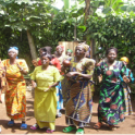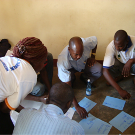Masaka District, Southwest Uganda
Over the past six months Elijah Kajubi (Uganda), Siobhan Girling (UK), Jeff DeBlieu (US) and Alba Perez (Spain/Vietnam) have been developing a project with 300 families in five villages in the Masaka District of southwest Uganda. These agricultural families are suffering from widespread malnutrition caused by water scarcity due to climate variability—including extreme drought reducing crop yields, causing crop failure and negatively impacting livestock.
| Challenges with water scarcity for farms and homes |
|
 |
The solutions that they have been developing and their project are to develop a community-based water use management plan which will combine local knowledge with scientific knowledge. Community members will first develop a participatory mapping of water resources and uses, and then consult with a water management expert to develop a participatory process and training program for developing the water use management plan. |
Water Use Management Plan [Solution to underlying causes: Water scarcity.]
[Activity 1]. Community-based workshop and survey with community members to identify their knowledge of water use
[Activity 2]. Facilitate the Organization of a community based Water Use Management Committee
[Activity 3]. Community workshop on participatory mapping of water resources and uses (consciousness raising)
[Activity 4]. Consultation with water management expert to develop a participatory process and training program
[Activity 5]. Committee participatory workshop on developing a community based Water Use Management Plan
[Activity 6]. Development of simple irrigation system adapted to local conditions in terms of local capacity and knowledge, and risk to landslides.
[Activity 7]. Development of simple water purification systems.
| Extreme drought is reducing crop yields, causing crop failure and negatively impacting livestock. |
|
 |
They are also developing an improved agricultural practices program which includes farmer workshops on soil and water conservation and management techniques.
|
Improved Agricultural Practices Program [Solution to underlying cause: Climate variability has reduced crop harvests; Inappropriate agricultural practices]:
[Activity 1]: Surveys and interviews to collect traditional knowledge on agriculture, changes in agricultural cycles, vulnerabilities and coping strategies
[Activity 2]: Develop plan that combines resilient and improved agricultural techniques with traditional knowledge for an overall improvement in productivity
[Activity 3]: Establish pilot plots demonstrating better cultivation practices
[Activity 4]: Farmer workshops on soil restoration and conservation techniques
[Activity 5]: Farmer workshops on water conservation and management techniques
[Activity 6]: Promotion of high yielding varieties/crops according to the changes in temperature.
Mulching
One of the soil and water conservation techniques which they’re using is to incorporate mulch into farmer’s fields and onto the beds of home gardens as a method of reducing evaporation. They have developed a consciousness raising workshop for the communities demonstrating how mulching can reduce evaporation.
The technique is quite simple.
1. Till and lightly moistened a small area of soil exposed to direct sunlight.
2. Mark off four small plots no more than half a meter square each.
3. Cover the first plot with a pane of glass raised about 10 cm above the soil surface.
4. Carefully and completely cover the second plot with chopped vegetation (straw, leaves, grass).
5. Loosely cover the third plot with chopped vegetation.
6. Leave the fourth plot uncovered.
Return to the test plots after one hour. Moisture should have begun to collect on the underside of the glass pane. Have the participants discuss where the moisture came from. This would be a good place to talk about soil evaporation and its effect on soils—and plants. Remove the glass and have the participants feel the soil beneath—it should still be moist.
Then have participants remove the mulch from test plots two and three. The soil should still be moist and plot two but less moist in plot three. Plot four, which was left uncovered should be even less moist and perhaps completely dry.
Scientific Knowledge
Recently, as part of project development, team Uganda researched scientific information on climate change and discovered that Uganda is experiencing unusual drought, storms, floods, high temperatures, pests and disease epidemics, heavy rains and landslides. Mean annual temperature is projected to increase by between 1°C and 3°C by 2060, and heavy rainfall is predicted to increase by 15% in the 90s. These challenges will lead to a reduction in crop yields which will translate into low incomes, food insecurity, pollutions of water sources, impacts on human health and land degradation.
Local Knowledge
Just this month Team Uganda led a participatory workshop in assessing community vulnerability and adaptation capacity. Workshop results showed that the community’s perspective is that there has been a change in the timing of the growing season, drought combined with increased heat waves, and unpredictable rainfall during the rainy season. These hazards are increasing the community’s vulnerability in the areas of water resources, income generation, and food security.
Coping Strategies
In interviewing community members, Elijah asked about their coping strategies and discovered that they have improvised some successful ones. The community’s watershed has gradually turned into a resource conflict area due to the receding water table caused by the drought and by the demand placed on it by different users. This has reduced their ability to grow traditional crops. Needing income generation activity, many of the farmers have resorted to growing vegetables such as cabbages, tomatoes, carrots and others which are readily sold on the roadside from kiosks do to interested travelers. Similarly, the farmers are harvesting rainwater from road runoff by channeling the water for storage into pits which they’ve dug adjacent to their vegetable gardens.
Access to water at the household level has also been a challenge. One solution has been to use a huge plastic polishing sheet, one end laid in a pre-dug pit, with the other and suspended underneath the eve of the roof to harvest roof water during rain. Using this technique is much less expensive than having to raise money to purchase tanks and tubing.
Download their report and needs assessment:
Vulnerability assessment workshop – with photos
Vulnerability assessment results and project outline
Would you like to learn how to develop Community Based Adaptation Projects?
Please write us with your stories, thoughts and comments through Online.Learning@csd-i.org